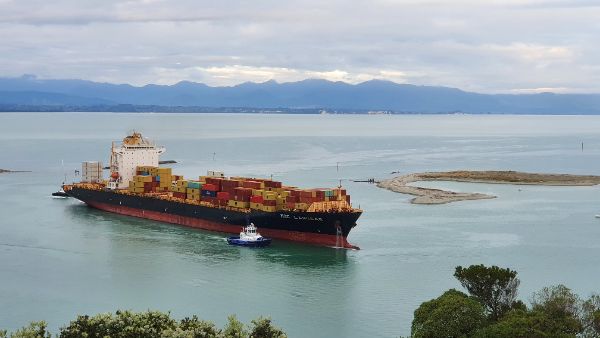Port Nelson Welcomes Back Bigger Ships To The Region

On Saturday 3 December, the container vessel MSC Langsar visited Port Nelson, marking the first time a larger vessel over 260m has berthed on Main Wharf South since its redevelopment.
The $20 million dollar investment to upgrade Main Wharf South was completed in November 2021. The upgrade resulted in redeveloping the main wharf's northern section, increasing the Port’s earthquake resilience, moving main wharf container operations further away from residential neighbours, and future-proofing the Port to accommodate larger vessels.
The trend towards the use of larger vessels has continued to grow over recent years as container shipping lines seek to optimise the environmental and economic efficiency of sea freight. Port Nelson has previously been able to routinely receive vessels up to 250m in length. The arrival of MSC Langsar is part of a process to normalise the arrival of vessels up to 265m in length. This increase in operating parameters comes following the investment some years ago in a new tug, the increase in the operating length of Main Wharf South and detailed modelling and planning for larger vessel movements. With this increased vessel capacity, Port Nelson will be well-placed to sustain international vessel arrivals for many years to come.
Along with the visitation of larger vessels, Port Nelson will also benefit from new and existing shipping services coming into or back to the region, including the commencement of a new trans-Tasman service from Move Logistics, starting next week.
Move Logistics will operate a vessel between Tasmania in Australia and a number of New Zealand Ports including Nelson. The new route provides a more efficient process, streamlining coastal freight links, and enabling direct delivery of fish feed from Tasmania, reducing costs for the industry. The service set to commence with a charter vessel next week has been welcomed news by customers of the aquaculture industry.
Container shipping continues to be constrained by berthing delays, labour shortages at New Zealand ports, and the pressures from the ad-hoc sliding of planned vessels continuing to force freight costs to remain high.
The planned increased capacity from the additional services and larger vessels calling into Te Tauihu will improve reliability and hopefully reduce costs for the region’s importers and exporters.


 New Zealand Association of Scientists: NZAS Supports Saving Biotechnology Capacity In Callaghan; Asks What Now For Applied Technology Group
New Zealand Association of Scientists: NZAS Supports Saving Biotechnology Capacity In Callaghan; Asks What Now For Applied Technology Group Stats NZ: Business Employment Data - December 2024 Quarter
Stats NZ: Business Employment Data - December 2024 Quarter Transpower: System Operator Launches Review Of Electricity Risk Forecasting Framework
Transpower: System Operator Launches Review Of Electricity Risk Forecasting Framework  The Conversation: NZ’s Glaciers Have Already Lost Nearly A Third Of Their Ice – As More Vanishes, Landscapes And Lives Change
The Conversation: NZ’s Glaciers Have Already Lost Nearly A Third Of Their Ice – As More Vanishes, Landscapes And Lives Change RBNZ: Reserve Bank Of New Zealand Welcomes The Release Of Te Ōhanga Māori 2023 Report
RBNZ: Reserve Bank Of New Zealand Welcomes The Release Of Te Ōhanga Māori 2023 Report Bill Bennett: Download Weekly - One NZ chooses Ericsson for core network update
Bill Bennett: Download Weekly - One NZ chooses Ericsson for core network update



